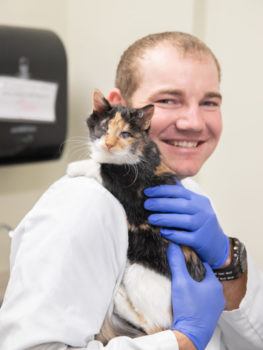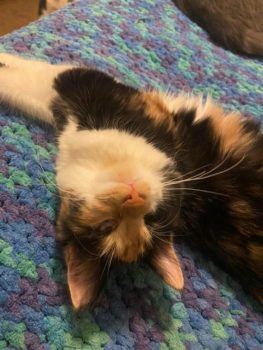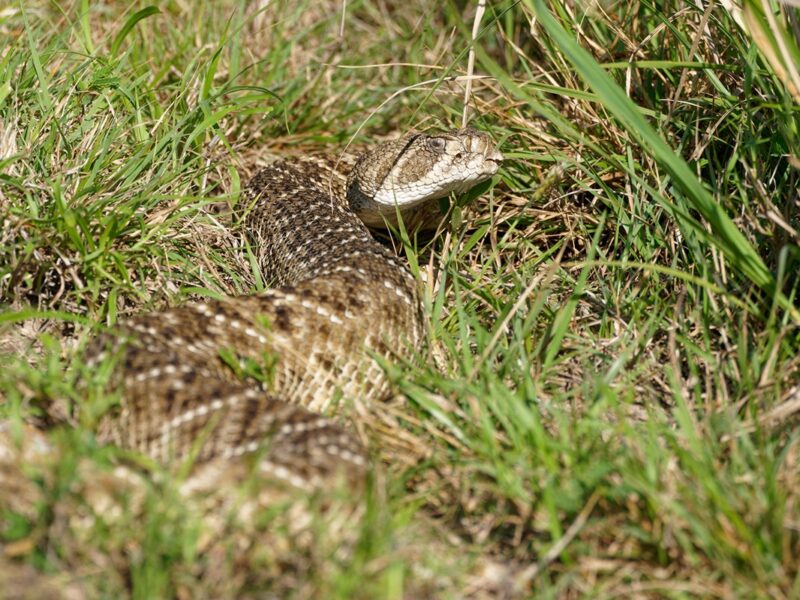Texas A&M Student Surgical Program Gives Kitten Lifesaving Eye Surgery

Life as a stray kitten is hard, and Gwennie knows this better than most. In her first eight weeks of life, the calico domestic shorthair had already caught a virus that damaged her eyes and left her essentially blind.
Fortunately, Gwennie was not on the streets for long, and once rescued, her owner and the Texas A&M Small Animal Teaching Hospital (SATH) veterinary team were dedicated to restoring her health and quality of life.
Her time at the SATH also had an added bonus in that it provided an unparalleled learning opportunity for one veterinary student at the Texas A&M School of Veterinary Medicine & Biomedical Sciences (VMBS).
Small But Mighty
Gwennie weighed only 1 pound when she was found by Sadie Tolbert, a Blinn College nursing student.
“My boyfriend and I were driving around and saw a whole herd of kittens in the middle of the road,” Tolbert said. “Later, we decided to go back to check on them and put out some food and water. I wanted to catch Gwennie because I could tell her eye was really infected; I knew she probably couldn’t see at all when she ran into a wall as I tried to grab her.”
After catching Gwennie and one of her siblings, a male kitten they named Simba, and noticing the pair was going to need medical care, Tolbert and her boyfriend decided to adopt them both.
“I’ve always rescued animals, and taking care of them is just what I do,” Tolbert said.
They took the kittens to Briarcrest Veterinary Clinic in Bryan, where they received the good news that Simba’s sinus infection would be an easy fix; they also received bad news — that Gwennie’s eye infection would be more of a challenge.
The veterinarian suspected that Gwennie had contracted a virus, most likely feline herpesvirus, that was causing inflammation and infection in her eyes. This inflammation had gotten so bad in her right eye that an ulcer had formed, and ruptured, on her cornea.
Her treatment would involve a costly surgery, one that Tolbert, a student paying her own way through college, was not able to afford. Fortunately, Texas A&M’s Roach Family Student Community Outreach Surgical Program was created for situations just like this.
This program gives fourth-year veterinary students at the VMBS additional opportunities to hone their surgical skills by performing a variety of common procedures. At the same time, the program supports Texas pet owners with limited financial means, who otherwise would not be able to provide their animals with surgical care, by offering these procedures at no cost.
“I just didn’t have the funds, and my only other option was to put her down or give her away,” Tolbert said. “I found the Roach fund online and I knew it was my only chance to keep her alive and with me.”
Healthy And Happy
Once Gwennie was accepted into the Roach Surgical Program and scheduled for her appointment at the SATH in mid-August, fourth-year veterinary student Parker Wurst volunteered to perform the procedure under the supervision and guidance of Dr. Brad Bennett, a VMBS clinical assistant professor in the SATH’s Primary Care and General Surgery services.
Because Gwennie’s right eye was too damaged to save, she was scheduled for an enucleation surgery, or a complete removal of the eye—a procedure performed often in general private veterinary practice.
“We don’t have to remove eyes as often as in the past, now that we have better ways to treat some things, but I’d say it’s still a pretty commonplace procedure,” Wurst said. “Fortunately, cats usually do great after losing an eye. They compensate with their other senses and they usually handle it pretty well.”

The surgery went smoothly and Gwennie healed perfectly without any complications.
“I feel 100% more comfortable doing this procedure going forward after having Dr. Bennett there to help me through it, whereas, without the Roach Fund, I wouldn’t have gotten that opportunity,” Wurst said. “After veterinary students graduate, we still have mentorship from whomever we work for, but it’s not the same as having that specific time with a teacher to go through the procedure.
“I am grateful for everyone at A&M, the Roach Fund, and Ms. Tolbert for letting me have this experience,” he said.
Because Gwennie’s left eye was not as badly infected as the right one, her veterinary team decided to see if it would heal from the infection rather than opting to remove it. The infection did heal with time but left the eye too damaged for vision.
“She’s going to be permanently blind for the rest of her life, but, other than that, she’s going to be healthy and happy. She’s already growing really fast and gaining a lot of weight,” Tolbert said. “Her favorite toy is a strawberry-patterned mouse and even though it doesn’t make noise, she has no problem handling it and finding it. She carries it with her everywhere.
“The Roach fund gave my kitten the chance of life,” she said. “She’s such a light in my life and I couldn’t have asked for a more supportive team at A&M. Gwen is happy, safe, and healthy and that’s all I could ever hope for!”
This article by Megan Myers originally appeared on the School of Veterinary Medicine & Biomedical Sciences website.





